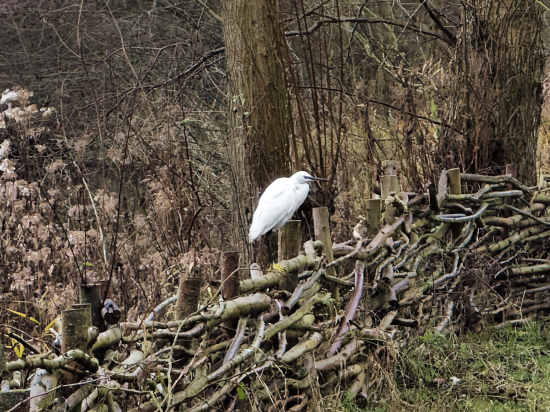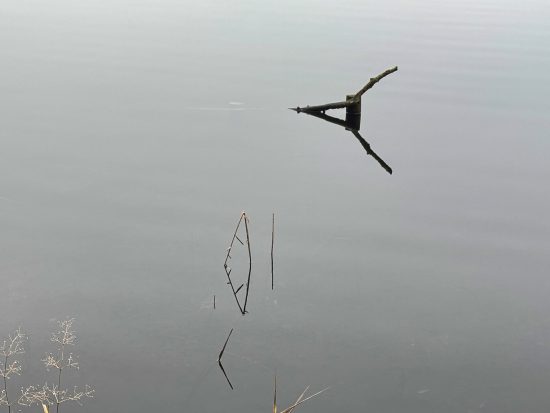It was a morning for being out and about as far as we were concerned, but the old and mizzle did not apparently suggest that to others. It was very quiet at the Lackford Lakes nature reserve managed by the Suffolk Wildlife Trust.
The weather made me rely on my phone, which was a shame, as I saw a warbler that was either a chiff-chaff or willow warbler, which would be very rare and I got no photographic evidence. But I did get a shot of this little egret, which would definitely not have been sitting where it was if there had been many people about:

They are quite magnificent birds.
However, this was probably my best photo of the morning:

I like the reflections, and it reflected (sorry) my mood.
Thanks for reading this post.
You can share this post on social media of your choice by clicking these icons:
There are links to this blog's glossary in the above post that explain technical terms used in it. Follow them for more explanations.
You can subscribe to this blog's daily email here.
And if you would like to support this blog you can, here:


 Buy me a coffee!
Buy me a coffee!

thank you for your reflections and photos – all I saw in Buxton were (too many) Canada Geese, along with some Mallard, a Moorhen and too many Jackdaws – the Canada Geese have chased away many of the native waterfowl, and ruined much of the grass areas (Pavilion Gardens) – they are now moving into people’s private gardens and can and do attack if confronted – one took a bite out of my (wooden) walking stick a while ago (I was on a tarmac path) and I now use a metal walking stick!. The Guardian today has an article on murmuration – ‘Young country diary: Outnumbered by hundreds of swooping starlings – North Yorkshire’ with a good photo.
I am afraid the answer might need to be a cull.
yes – but some people think that they should be allowed to take over – and indeed feed them with bread (ouch) and encourage them – when ‘cull’ was mentioned, there were those who were horrified. At the moment there are signs stating ‘do not feed the birds’ (which signs are ignored) and plants and small bushes are, in some places, being placed along the water edge, and some low fencing to discourage them. One lady was badly bitten recently (on her backside) and children have been attacked, plus people have slipped and fallen on the goose poo – I have warned the council that it is possible that someone could sue, but —-
We had this problem with Muscovy ducks – and a cull worked.
persuade some (please)
Little Egrets (the only Egrets to live in Britain) are indeed splendid – there is one who is occasionally in evidence on quiet days by the Great Ouse where the Nar flows into it just south of King’s Lynn.
Thomas
I have seen them just where you describe, but they are not the only egrets here now.
Great white egrets have become increasingly common over the last decade and are magnificent, whilst cattle egret are regularly seen at Welney, and elsewhere, but they are definitely rarer, and quite different in habit. It is quite common to see all three in a day at Welney at present.
Best
Richard
Hi Richard, the warbler would be a ChiffChaff a not uncommon site these days in suitable habitats in the winter. I remember seeing my first overwintering Chiffchaff in Plymouth in 1979-’80.
Just under two weeks ago I saw my first Blackcap of this winter in my garden briefly, a female. Birds from central Europe increasingly winter here.
I recognise it could be a chiff chaff, but I also know both birds reasonable well now and I think it was a willow warbler. There are similarities but the plumage on the willow warbler is much more yellow, and this was. Unfortunately, I did not nite the feet, which would have proved my case. Either way I was very pleased. And I was actually on the look out for blackcap – which are common in that area, knowing they do now over winter.
Pete Bickford
Hello, i’m new to this site and, for the most enjoy it. But i must take issue with a couple of comments. I agree there are too many Canada geese; the most humane way to reduce their number is to find their nests and prick all but one of the eggs. Instinctively the birds carry on incubating and will bring up the one young. They creche, and if all nests in the area are treated in the same way the birds will naturally decline. It is far more humane, less obvious to the public and far less intrusive and less cruel to the birds. Canada geese, as far as we know, are not native and so can possibly upset a balance. But remember it is we who, most likely introduced them. It is not their fault they are here. And, like all wildlife, should be treated with with a degree of sensitivity.
As regards jackdaws (too many) this is a different. Jackdaws are a native species. When i first started birdwatching 60 years ago they were much less common and were confined to farmland, mainly. They have increased massively, but in the Anthropocene that we and they now live in we must be careful when we suggest their are too many of something, especially when they are native. They are survivors in a land/world that we frankly control, manage and exploit. I wonder, would you think that wonderful blue eye, that subtle grey hood, their undoubted intelligence, were something more beautiful if they were rare.
i assume you think the chough is more attractive. And remember the passenger pigeon was once considered the most numerous bird in the world, it was ‘too common’. It’s extinct now.
Thanks
Noted
I like these ideas